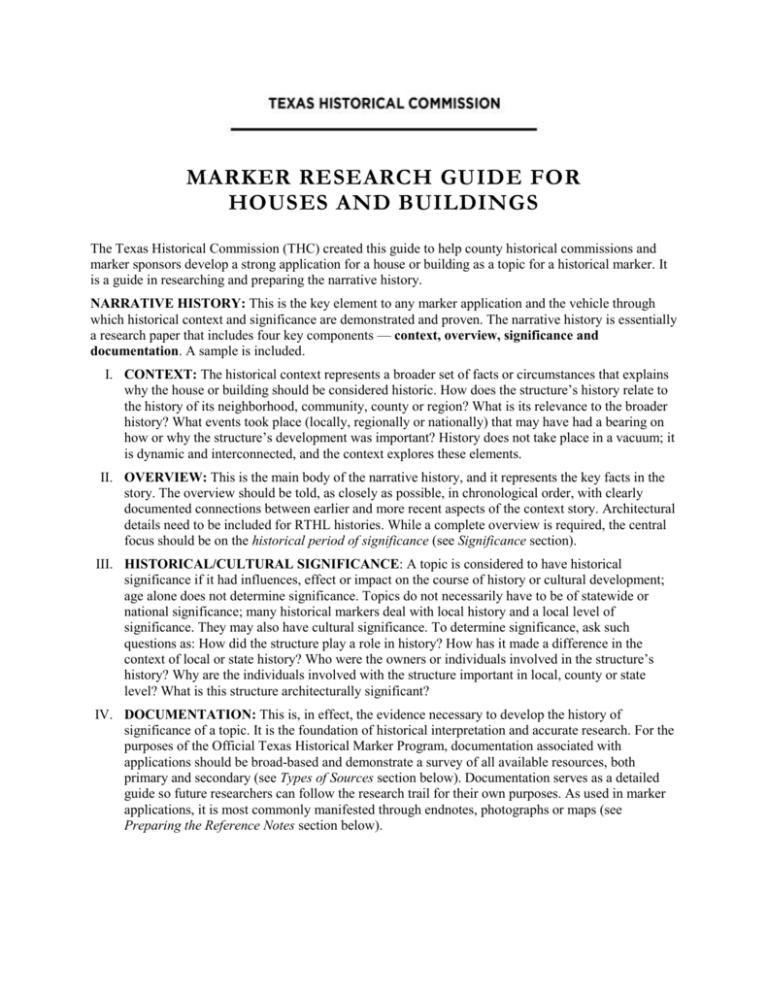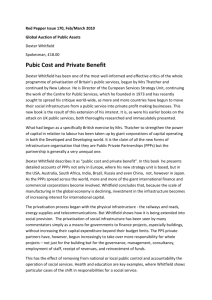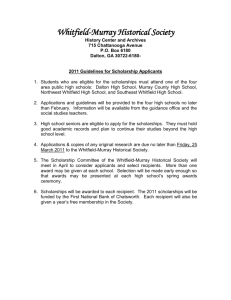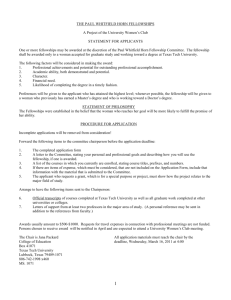Structures: Houses and Buildings
advertisement

MARKER RESEARCH GUIDE FOR HOUSES AND BUILDINGS The Texas Historical Commission (THC) created this guide to help county historical commissions and marker sponsors develop a strong application for a house or building as a topic for a historical marker. It is a guide in researching and preparing the narrative history. NARRATIVE HISTORY: This is the key element to any marker application and the vehicle through which historical context and significance are demonstrated and proven. The narrative history is essentially a research paper that includes four key components — context, overview, significance and documentation. A sample is included. I. CONTEXT: The historical context represents a broader set of facts or circumstances that explains why the house or building should be considered historic. How does the structure’s history relate to the history of its neighborhood, community, county or region? What is its relevance to the broader history? What events took place (locally, regionally or nationally) that may have had a bearing on how or why the structure’s development was important? History does not take place in a vacuum; it is dynamic and interconnected, and the context explores these elements. II. OVERVIEW: This is the main body of the narrative history, and it represents the key facts in the story. The overview should be told, as closely as possible, in chronological order, with clearly documented connections between earlier and more recent aspects of the context story. Architectural details need to be included for RTHL histories. While a complete overview is required, the central focus should be on the historical period of significance (see Significance section). III. HISTORICAL/CULTURAL SIGNIFICANCE: A topic is considered to have historical significance if it had influences, effect or impact on the course of history or cultural development; age alone does not determine significance. Topics do not necessarily have to be of statewide or national significance; many historical markers deal with local history and a local level of significance. They may also have cultural significance. To determine significance, ask such questions as: How did the structure play a role in history? How has it made a difference in the context of local or state history? Who were the owners or individuals involved in the structure’s history? Why are the individuals involved with the structure important in local, county or state level? What is this structure architecturally significant? IV. DOCUMENTATION: This is, in effect, the evidence necessary to develop the history of significance of a topic. It is the foundation of historical interpretation and accurate research. For the purposes of the Official Texas Historical Marker Program, documentation associated with applications should be broad-based and demonstrate a survey of all available resources, both primary and secondary (see Types of Sources section below). Documentation serves as a detailed guide so future researchers can follow the research trail for their own purposes. As used in marker applications, it is most commonly manifested through endnotes, photographs or maps (see Preparing the Reference Notes section below). TYPES OF SOURCES FOR HOUSE AND BUILDING RESEARCH The THC will consider the objectivity and reliability of information sources used in compiling a narrative history. Whenever possible, consult primary source material. Primary sources ― those that are contemporary with the topic ― include newspaper accounts, diaries, meeting minutes, deed records, census records and legal documents. Such sources, as well as the recollections of disinterested, unbiased and authoritative persons, are preferred over secondary sources. When using secondary sources, check them thoroughly since they are often not as reliable as primary sources. Secondary sources, such as history books, are not contemporary with the topic’s history. Oral histories collected from authoritative sources are valuable research tools if properly documented (see example at the end of this document). Any claims of uniqueness (earliest, oldest, first, largest, etc.) must be accompanied by factual documentation from an authoritative, unbiased source. SUGGESTED SOURCES FOR COMPILING STRUCTURE HISTORIES Government Records Municipal (building permits, minutes of official meetings, ordinances, tax records) Contracts (abstracts of title, court records, deeds, probate records, tax records, mechanics liens) State (land records, homestead records, mineral rights records, transportation records) Military (pension records, biographical information) Institutional Records Cemetery (family relationships, birth and death dates) Church (biographical information on birth, death, marriage; congregational records) School (biographical information, building information, social history) Fraternal (membership information, dates, building information) Corporate Records Ledgers, client files, advertisements, mortgages Published Histories County (information on buildings, people, institutions, events) Community (information on buildings, people, institutions, events) Business (commercial trends, economic base of community) Fraternal (building information, social history) Handbook of Texas, Texas State Historical Association, online or print Architectural Sources Drawings (architect/builder, original appearance, date, specifications) Publications (information on style and date, biographies of architects) Pattern books (residential, agricultural, commercial) Family Papers Deeds (ownership, property value, associated improvements) Letters and diaries (biographical information, building information, social and economic history) Photographs (biographical information, building information) Genealogical information (family relationships) Estate records (dates, building information, transfers of land not recorded by deeds) Directories and Gazettes City directories (addresses, approximate dates, occupations) Business directories (addresses, images of building, approximate dates) Social directories (biographical information) Rural directories (trading connections, farm locations) Maps and Plats Sanborn maps (plans, dates of construction, materials, settlement patterns) Bird’s Eye View maps (building information, settlement patterns, natural features) Property and subdivision plats (building hierarchies, dates, settlement patterns) Landscaping layouts (land use changes, outbuildings, agricultural or garden history) Photographs and Printed Images Family photographs (biographical information, building evolution, landscape changes) Postcards (biographical information, building evolution, landscape changes) Newspapers and Journals Advertisements (owner information, dates, building information, neighborhood development) Society pages (biographical information on civic leaders, institutional history) Obituaries (biographical information) Articles (significant local events, economic history, social history, building information) Oral Histories Minority history, social history, business history, building evolution and uses The Building Itself (for NR and RTHLs) Comparative information with other buildings, evidence of changes and evolution, construction techniques, wall paper and paint from historic periods, hardware Online Sources Texas Reference Sources (http://www.txla.org/pubs/trs/trsonline.html) Portal to Texas History (http://texashistory.unt.edu/) The Handbook of Texas Online (http://www.tshaonline.org/handbook/online/) PREPARING THE REFERENCE NOTES For the specific purposes of the Official Texas Historical Marker Program, the required means of resource documentation to be used in preparing the historical narrative are reference notes. Generally speaking, facts that cannot be assumed to be common knowledge should be documented with a reference note. They can be either footnotes (placed at the foot of the page on which the fact is mentioned), endnotes (listed sequentially at the end of the history) or parenthetical notes (placed in parentheses immediately following the fact within the narrative history). The notes must be complete so the reader finds the referenced source easily. Regardless of which type of reference note is used, the first use of a source should include a full first citation (all relevant resource details) with abbreviated information thereafter in subsequent citations (see examples below). Note: With the use of full citation footnotes, a bibliography is no longer a required element of marker applications. Examples of First Full Citations (Footnotes or Endnotes): 1 Terry G. Jordan, Texas Graveyards: A Cultural Legacy (Austin: University of Texas Press, 1982), p. 79. 2 Orange County Deed Records, Book 4, p. 139. 3 1900 United States Census, Fort Bend County, Texas (Roll 1553) Enumeration District 16, p. 16. 4 Bessie Jones. Interview with Scotty Jergenson, June 21, 1991. Tape recording and transcript available at the Darrouzett Public Library. 5 Letter from Maria Gutierrez to Henry Guerra, May 23, 1922. Private collection of Henry Guerra, Dallas. 6 “ San Jacinto Monument Reconditioned.” Temple Daily Telegram, Vol. 76, No. 256; July 31, 1983, p. 5-C. Examples of Subsequent Citations: 9 Jordan, p. 83. 10 Orange County Deed Records, p. 140. 11 1900 United States Census, p. 23. 12 Jones, 1991. 13 Gutierrez letter. 14 Temple Daily Telegram, 1972, p. 5-C. Note: For sources used in preparing the text but not specifically cited, list them separately under the heading ADDITIONAL SOURCES. For further assistance on reference note styles, see the following guides, or contact your local library. Chicago Manual of Style, 14th ed. Chicago: University of Chicago Press, 1993. MLA Handbook for Writers of Research Papers, Theses and Dissertations. 5th ed. New York: Modern Language Association, 1999. Turabian, Kate L. A Manual for Writers of Term Papers, Theses and Dissertations. Revised by John Grossman and Alice Bennett. 6th ed. Chicago: University of Chicago Press, 1996. HOUSES AND BUILDINGS RESEARCH CHECKLIST Narrative histories submitted to the THC in support of marker applications for houses and buildings should include, but not necessarily be limited to, the following information. Note: Structures may be considered eligible for the Recorded Texas Historic Landmark if they are at least 50 years old and exhibit both architectural and historical significance. They are not, however, eligible for subject markers. Historic name, with background information Location Date of construction and complete construction history, including building materials used, major alterations, etc. Architect, if known, and some biographical history Builder/contractor, if known First owner, and subsequent owners and occupants, with background information: Owner/occupant names Vital dates of occupancy Dates owners/occupants were associated with the structure Owners’/occupants’ association with any major alterations to the structure Owners’/occupants’ biographical data, such as family information, education, vital dates, professional/business activities, community activities, military service, public service, etc. Brief architectural description Organizations/businesses that have occupied the structure, with a brief history of each Information on surroundings and setting, such as significant outbuildings, landscape features, relationship to adjacent properties, etc. Texas Historical Commission History Programs Division P.O. Box 12276, Austin, TX 78711-2276 Phone 512/463-5853 history@thc.state.tx.us SAMPLE HISTORY: Houses & Buildings NOTE: This sample history, comprised of fictional information, represents in format, scope of content, documentation and length the type of narrative history required for a historical marker application. It is presented as a general guide for developing a narrative of a house or other structure. JAMES AND WINIFRED WHITFIELD HOUSE I. CONTEXT The town of Smackdab was platted in the geographic center of Post Oak County in 1876, envisioned as the seat of the newly established county. Following a bitterly contested election, the state legislature instead awarded that honor to Jergenson (7 mi. N), and Smackdab remained a small village for more than a decade. After the Texas and Northern Railroad built a tap line from Jergenson in 1889, Smackdab experienced steady evolution from a frontier settlement to a center of commerce and education. By the mid-1890s, the railroad was regularly supplying the transportation, communication and raw materials that stimulated local business. Smackdab experienced an era of sustained development during the early decades of the 20th century, sparked by the construction of a state highway in 1906 and by the discovery of oil and natural gas one mile east in 1912. New home and business construction peaked in the mid-1910s, and among the more substantial historic homes in Smackdab from that period is the James and Winifred Whitfield House.1 II. OVERVIEW In the same year that a new Post Oak County Courthouse was built in Jergenson, the James and Winifred Whitfield House was built at 1113 Elm Street in Smackdab. Completed late in 1915, it was built by the Woody Lumber Company of Smackdab. The project, along with others, provided a phoenix-like return for the firm, destroyed by a fire the previous year. Charles Thomas Melton (1854-1937), president of the company and one of Smackdab’s prominent business leaders, supervised all construction projects. His attention to detail and his reputation for quality craftsmanship are evident in the home and in his other projects, including the Lower Valley Lutheran Church near Flathead and the First Methodist Church of Smackdab.2 The contract book of the Woody Lumber Company for the period 1913-1916 shows the residence at 1113 Elm was constructed between January and July 1915, at a cost of $7,135.47. Tax records from that time also indicate a substantial increase in valuation for 1915.3 Melton built the home for James Whitfield (1866-1929), a prominent local attorney and later county judge, and his wife Winifred (Sadler). A two-story buff-brick residence, it reflects the American Four Square design with strong influences of the Prairie School style. It features wide, overhanging eaves and an expansive front porch with Tuscan columns, a brick-wall balustrade and an offset front entry with sidelights. The windows, of varying size and design, include decorative transoms. Of particular note are the window designs on the north elevation (the home faces east), which include paired windows under a single lintel and a round-arched window. The size and design of the home reflect Whitfield’s stature and his standing as one of the leading citizens of the community. 4 A native of Smackdab, James Whitfield was the son of Col. and Mrs. Arnold Whitfield. He attended Middle Texas University and later, with his brother-in-law and cousin Johann, operated a local newspaper, the Smackdab Gazette, from 1886 to 1889. He studied law with the firm of Dodd and Dodd, passed the state bar exam and began his legal practice in 1890. As was common of young lawyers in small towns across the state at the time, he also served two terms as city attorney.5 James Whitfield married Winifred V. Sadler (1874-1955) of Sempronius, Texas, on June 11, 1894 at Smackdab Church of Christ. Winifred’s parents were Col. Maxwell R. Sadler, commander of the 15th Cavalry at Fort Sensible from 1878 to 1886, and Ophelia M. (Buttery) Sadler, a classically trained violinist. Winifred gained fame in the late 1910s as a suffragist, using her house at 1113 Elm Street for meetings with state officials to persuade them to support women’s voting rights. After the Buchanan Bill permitted women to vote in primary elections in 1918, the Whitfield home was the scene of a series of Sunday teas where Winifred invited all women in a three-county area to register to vote. Over a threemonth period from August to November, 1918, Winifred was personally responsible for registering 3,115 women to vote. On Election Day, November 4, 1918, the female voting bloc from Edson, Post Oak and Tilden counties helped elect John T. Ribald as state representative over six-term incumbent Washburn Thompson, a fierce opponent of woman suffrage. Ribald received 87 percent of the women’s vote, enough to defeat Thompson by more than 1,500 votes. Three months later, Ribald sponsored the bill that extended women’s voting rights to all of Texas. 6 Very early in his professional career, Whitfield established himself as a civic leader. He was trustee of the local school district for many years, but was also active in the support of religious education. He was instrumental in the founding of Marion Presbyterian College, where he served on the board of trustees. The school, established in the Tisdale County town of Marion in 1901, remained in operation until 1924, when it merged with Salem College in Carrington.7 Whitfield also served on the board of a Tisdale County Presbyterian orphanage which he helped create. James Whitfield was interested in politics and served actively in the Democratic Party. In 1912, he was a delegate to the Democratic National Convention. His role in the convention was in no way small; as part of the “dirty thirty,” the Texas delegation under the leadership of Judge David Summers, he helped secure the presidential nomination for Robert M. LaFolette.8 In Smackdab, Whitfield is perhaps best remembered as a legislator and jurist. He served as state representative from Post Oak County in the 26th Texas Legislature (1901-1902), participating in one regular session and one called session.9 In 1921, Governor Pat Jackson appointed Whitfield to fill the unexpired term of Judge Roy Washburn of Allentown, who retired as civil district judge of the 58th Judicial District. Judge Whitfield subsequently won election to the post, and in 1924 the district was divided to cover only Post Oak County. His success as a firm but respected jurist is shown through the words of his obituary: Judge Whitfield lived by two statutes - fairness and mercy. No one ever stood before him and walked away without the feeling that justice, no matter how painful it might be, had been done.10 Judge Whitfield died August 2nd, 1929, while in Springfield for medical treatment. The record shows the cause of death as secondary infection. He was buried three days later in the City Cemetery of Smackdab. The notice of Judge Whitfield’s death appeared on the front page of the Smackdab Gazette, signifying his service to the community as a legal, political, religious and civic leader. The words of the obituary, written in the elegant style of the era, leave no doubt about his contributions to his hometown: Although Judge Whitfield has left us, his legacy will not; it is imprinted on faces of each man, woman and child in town. His role in our lives will not soon be forgotten.11 Judge Whitfield was survived by his wife Winifred, who died February 7, 1955. Her will, written in 1938, left much of the estate to the Central Texas Presbyterian Orphans’ Home (later Heathrow Children’s Home) near Peja, Texas.12 The family home at 1113 Elm was sold as part of the settlement of her estate. The buyers, with a bid of $9,854, were Joe and Mimi (Kent) Williams.13 Mimi Williams was a distant relative of James Whitfield. Joe Williams was a textbook salesman for the Hoyt and Baines Company and set up his office in the small building behind the house. In 1976, he became superintendent of the Green Hills school district in Tisdale County, Texas, where he had previously worked. He died there about 1981.14 Subsequent owners of the James and Winifred Whitfield House include: J.D. “Moose” and Christine Boentges, 1968-1971; Grady and Carol (Smith) Jordan, 1971-1975; and B.W. and Kate (Cameron) Sullivan, 1975-present.15 During their ownership, the Boentges screened the porch on the rear of the home (west side) and converted it to accommodate a new kitchen, bedroom and bath. They also added a new porch to the east side. Decorative wrought ironwork they added to the façade was removed later during the Jordan ownership. The Sullivans converted the rear porch into a sun room and made the carport (added by the Boentges) into a garage. The Sullivans also replaced window screens to uncover the detailed window transoms. The screen treatment was suggested by architect Walter Lee. III. SIGNIFICANCE In 1983, the James and Winifred Whitfield House was included in the Smackdab Historic District multiple-resource nomination approved for listing on the U.S. Listing of Historic Properties. It is one of the most prominent large residences from the early 20th century to survive intact in Smackdab. Minor changes to the exterior after the historic occupancy of Judge Whitfield were reversed to their original appearance. The building retains integrity of original materials and design to a high degree, and is significant primarily as the best-preserved example of an early-20th century upper-middle class residence in Smackdab. It is one of the best local examples of American Four Square and Prairie School style architecture in town, and was designated a local landmark in 1977. It is also the most prominent example of a historic residence by the important local firm, the Woody Lumber Company, and contractor Charles Thomas Melton. As a symbol of Smackdab’s development in the early-20th century, and as a reminder of a prominent couple, one a jurist, benefactor and civic leader, and the other a noted suffrage leader, the residence is an important landmark in the town. VI. DOCUMENTATION 1 Prater, Elihu. Beyond the Rim: A History of Early Post Oak County. Smackdab: Post Oak County Historical Commission, 1978. p. 224. 2 Prater, p. 319. 3 Woody Lumber Company contract book, 1913-1916 (Photocopied, in possession of Kate Sullivan), p. 19, 11-12; Post Oak County tax rolls, 1914-1916 (microfilm available at Post Oak County Library). 4 “A Stroll Through Smackdab,” Smackdab Gazette, May 3, 2004. 5 Smackdab Gazette, August 4, 1929. 6 Smackdab Gazette, November 10, 1916; Dallas Evening News, January 23, 1917, p. 1, col. 1-4; Ribald, John T. Solon, It’s Been Nice To Know You. Austin: Tejas Press, 1927, pp. 18-29; Smackdab Gazette, February 9, 1955. 7 Ryan, Cary, Big Book of Universities in Texas. Allentown: McMurray Press, 1992. p. 147. Walker, Nate, ed. “David Summers,” The Texana Handbook. Austin: Smith Texana Publishers, 1999. Vol. 5, pp. 198-199. 8 9 Smackdab Gazette, August 4, 1929. 10 Smackdab Gazette, August 4, 1929. 11 Death records, V. 1, p. 79, Office of the Post Oak County Clerk, Post Oak County Courthouse, Jergenson. 12 Probate records, Office of the Post Oak County Clerk, Post Oak County Courthouse, Jergenson. 13 Probate records. 14 Statement by Angelica Williams Yates (daughter of Joe and Mimi Kent Williams) to Kate Sullivan, November 1987; “Additional notes on 113 Elm Street,” Smackdab Heritage Club files. 15 Deed records: V. 91, p. 245; V. 286, p. 601; V. 355, p. 289; V. 427, p. 79, Office of the Post Oak County Clerk, Post Oak County Courthouse, Jergenson. Texas Historical Commission History Programs Division P.O. Box 12276, Austin, TX 78711-2276 Phone 512/463-5853 Fax 512/475-3122 Email history@thc.state.tx.us







